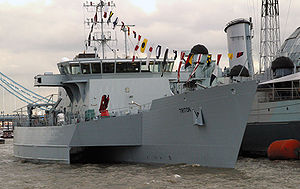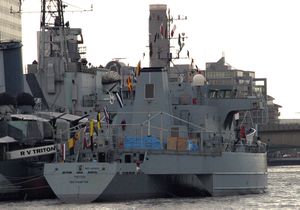RV Triton
 RV Triton berthed alongside HMS Belfast in the Pool of London | |
| Career (United Kingdom) | |
|---|---|
| Name: | RV Triton |
| Namesake: | Triton |
| Ordered: | August 1998 |
| Builder: | VT Group |
| Acquired: | August 2000 |
| Fate: |
Sold to Gardline Marine Sciences, 2005 Leased to Australian Customs Service, December 2006 |
| Career (Australia) | Australian Customs Flag |
| Name: | ACV Triton |
| Acquired: | December 2006 |
| Status: | Active as of 2010 |
| General characteristics | |
| Displacement: | 800 tonnes |
| Tons burthen: | 1,200 tonnes |
| Length: | 318 ft 3 in (97.00 m) |
| Beam: | 73 ft 8 in (22.45 m) |
| Draught: | 10 ft (3.0 m) |
| Propulsion: | Diesel electric propulsion, Single shaft |
| Speed: | 20 knots (37 km/h) |
| Range: | 3,000 nmi (5,560 km) at 12 knots (22 km/h) |
| Complement: | 14 crew and up to 28 Customs Officers (Australian service) |
The Research Vessel Triton is a trimaran vessel owned by Gardline Marine Sciences Limited and a former prototype British warship demonstrator for the UK's Defence Evaluation and Research Agency. She was built as a technology demonstrator ship for the Royal Navy's Future Surface Combatant, and has been used to both prove the viability of the hull-form and as a trials platform for other QinetiQ innovations.[1]
The Triton name is a reference to the maritime god Triton who carried the three pronged spear, the trident, which relates to the vessel's three parallel hulls.[citation needed] The outriggers are thinner and much shorter than the dominant central hull.
Contents
Operational history
DERA and QinetiQ
The Triton was designed as a demonstrator to prove that the trimaran concept would work successfully in a large warship. Following her launch in 2000, the ship began an extensive series of trials in 2001, which covered general ship handling, performance, sea-keeping behaviour, but also more specific areas to its design that the Royal Navy had no experience of — for example, a series of docking manoeuvres were undertaken by the pilot boats of HMNB Portsmouth to determine the problems of docking a large trimaran, while the ship underwent underway replenishment alongside HMS Argyll and the tanker RFA Brambleleaf to ascertain the characteristics of a trimaran and a monohull replenishing at the same time.[citation needed] The Triton also undertook the first helicopter take off and landing on a trimaran.[2]
RV Triton was present at the International Festival of the Sea in 2001, but visitors were not permitted on board.[citation needed]
Gardline Marine Sciences
Following the end of the Future Surface Combatant project, it was decided that the Triton was no longer necessary, so in 2005, she was sold to Gardline Marine Sciences Limited and has been converted into a multi-role survey vessel; among other projects she is being used as part of the Civil Hydrography Programme on behalf of the United Kingdom's Maritime and Coastguard Agency.[citation needed]
Australian Customs
In December 2006, Gardline contracted the Triton to the Australian Customs Service to patrol Australia's northern waters as one of the service's fleet of patrol vessels. Australian Customs Vessel Triton has been fitted with two .50 calibre heavy machine guns and carries up to 28 armed customs officers. The ship arrived from the UK in mid-January 2007 and started operations immediately[3] It is reported that ACV Triton has been modified to provide additional accommodation at the expense of ballast, which has apparently reduced the vessel’s inherent stability.[citation needed] Note that especially high stability is intrinsically less important in the calmer waters of the South Pacific and Indian Oceans.[citation needed]

